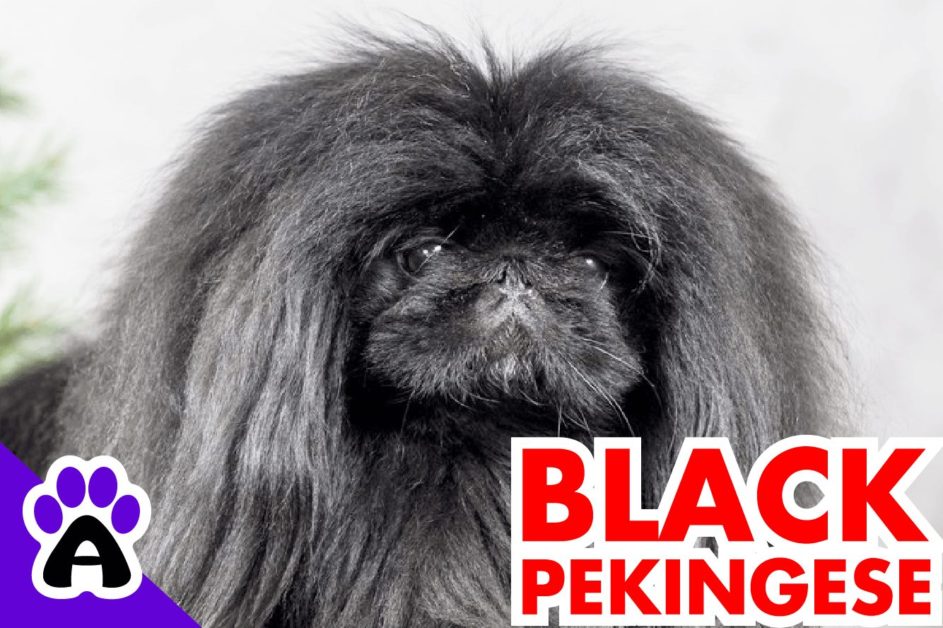Black Pekingese is full of majesty and aristocracy. It’s calm, independent, and a little arrogant: it loves to be groomed and pampered.
At the same time, the black Pekingese knows no fear and is capable of selfless devotion. But at the same time, the black Pekingese loves to put things in order and considers itself the first person in the house, which it tries to remind with its behavior at every opportunity.
Black Pekingese: History & Origin
Dogs similar to modern black Pekingese appeared in ancient China more than two thousand years ago.
According to one of the legends about their origin, the Pekingese descended from the marriage union of a lion and a monkey. Since the lion was too big, it went to the Buddha and asked him to help.
The Buddha listened to the request and reduced it to the size of a monkey. Born from this union, the Pekingese inherited from a lion a lush mane and majesty, and from a monkey – an awkward gait, a characteristic muzzle, and rich facial expressions.
For many centuries, the Pekingese did not leave the territory of China. Only in exceptional cases, the emperors, as a sign of respect, gifted them to foreigners who provided special services to the ruling dynasty.
These dogs came to Europe after 1860, after the Imperial Summer Palace in Beijing was captured by British soldiers. Having found five Pekingese survivors in the women’s chambers of the palace, the British sent them as a gift to Queen Victoria.
Currently, black Pekingese dogs are used as companion dogs and exhibitors. And although dogs of this color are less popular than red or cream, they have their own admirers.
Black Pekingese: Purebred or a Mix?
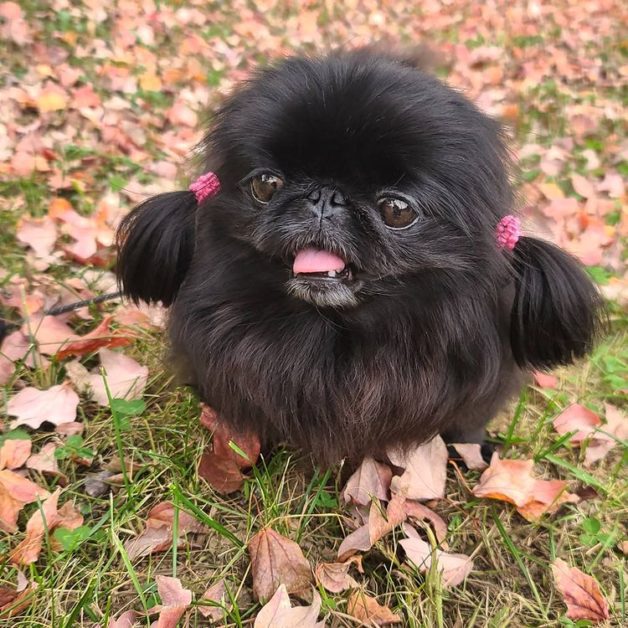
According to the breed standard, any color is permissible in Pekingese, except for white, associated with albinism. Therefore, the black color of the coat cannot be considered an offspring of the breed
Pekingese are brave dogs that, despite their small size, are ready to fight an enemy that is much larger than them.
The upbringing is somewhat complicated by the fact that they consider themselves the center of the universe and demand from others respect and even respect for their person.
The owner of the black Pekingese from the first day of the appearance of the pet in the house must let the puppy understand that the leader in the family is the owner, and therefore the dog must obey the owner.
Pekingese are best suited for a family of adults or for a single person.
They can get along with children, but their regal arrogance will not allow them to condescend to the fact that the kids tease them or annoy them. But with older children, they get along well.
These dogs are independent and there are positive aspects to this: being alone, the dog will not misbehave, but will find itself in peaceful entertainment.
Black Pekingese: Color features
Among the representatives of this breed, you can find animals with several variations of black color.
The Black Pekingese
The color of the puppy’s coat is laid in the embryonic stage and depends on the predominance of one or another gene over the rest. If the genes for solid color and black turned out to be dominant, the puppy will be born completely black. This shade is formed due to the high content of the coloring pigment melanin in the hair structure. However, it can easily disintegrate, and babies of a completely different color can be born.
The Black and white Pekingese
The appearance of black and white pets also depends on the dominant genes. If the dog was dominated by the spotting gene, then black and white puppies may appear in the litter. Color pigment also plays a role. If its location in the villi of the wool is annular, then the color of the Pekingese will turn out to be uneven.
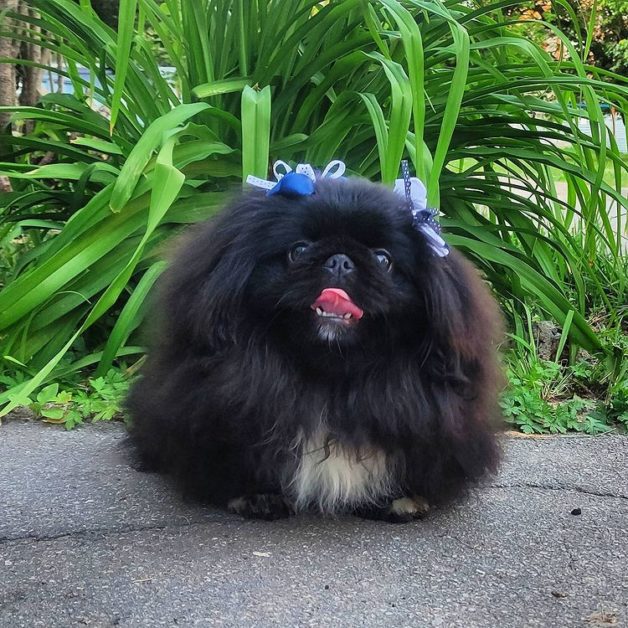
According to legend, this mark is believed to be the blessing of the Buddha himself.
Black and tan Pekingese
This type of color is characterized by zones of a different color, which are located in certain places according to the breed standard: on the chest, on the inner side of the thigh, around the anus, above the eyes, on the cheeks. The color of the markings is determined by the pigment phaeomelanin. They can be either deep red or light yellow.
- Dogs of a zone-gray color appear gray or black with gray hair if the rings of black pigment are wide, and the pigment itself is located at the tips of the hairs.
Black Pekingese: Genetics Behind The Color
Black is the “default” eumelanin colour for dogs. A dog that isn’t homozygous for liver (bb) or for dilution (dd) will have black eumelanin. This means that it will have a black nose and, usually, brown eyes (eumelanin affects eye colour too), and any eumelanin in its coat will be black. Eumelanin is one of two types of pigment that occur in dogs.
The other is phaeomelanin, which doesn’t affect the eyes or nose and is only visible in the coat. It produces the colour “red”, which is anything from deep Irish Setter red to light cream. Phaeomelanin only appears in the coat if the dog has particular genes that allow it to occur, and these genes also control how it is distributed throughout the coat.
Black Pekingese: Breed Standers
According to the current standard, the weight of an adult thoroughbred male should be in the range of 8–12.5 pounds, and that of a female – 9–13.5 pounds. The minimum height of these dogs in adulthood is 6 inches, the maximum is 9.75 inches.
Breed standard
The current standard gives the following characteristics of the breed:
- The head is large, with a flat crown and an overhanging forehead. The transition from the forehead to the nose is pronounced.
- The nose is wide, flattened, with large, well-open nostrils, pigmented with black.
- The eyes are round, large (sometimes even bulging), with a dark iris and black eyelid rim.
- The ears are small, cordate, set high, drooping, close to the head. Their length reaches the line of the lower jaw.
- The teeth are small and even. The lower jaw protrudes slightly forward.
- The neck is thick and short.
- The body is rectangular, short, with a heavy front, a well-defined waist, and a straight back.
- The limbs are short, strong, rather thick.
- Paws are large and flattened. The front legs are turned out slightly, and the hind legs are looking straight.
- The tail is set high, slightly curved towards the end, lies on the back or on the thigh, covered with thick and long decorating hair.
- The coat is two-layered: with a dense, dense undercoat and a long, coarse guard hair.
- The color is varied.
Varieties
To date, there is no official division into the varieties of Pekingese. However, amateurs still distinguish the following types of Pekingese:
- Dwarf Pekingese. In another way, such individuals are called sleeve, pocket, or mini-Pekingese. They are not considered a separate species, as they are born to parents of standard sizes, and the small size of these dogs is a genetic defect. Despite the fact that in all parameters, except for size, dwarf Pekingese meet the breed standard, they do not take part in further breeding.
- Imperial or royal Pekingese. Such individuals are dogs that fully comply with the breed standard. The title “imperial” or “royal” is usually added to the name of the breed only by unscrupulous breeders in order to increase the value of the dog.
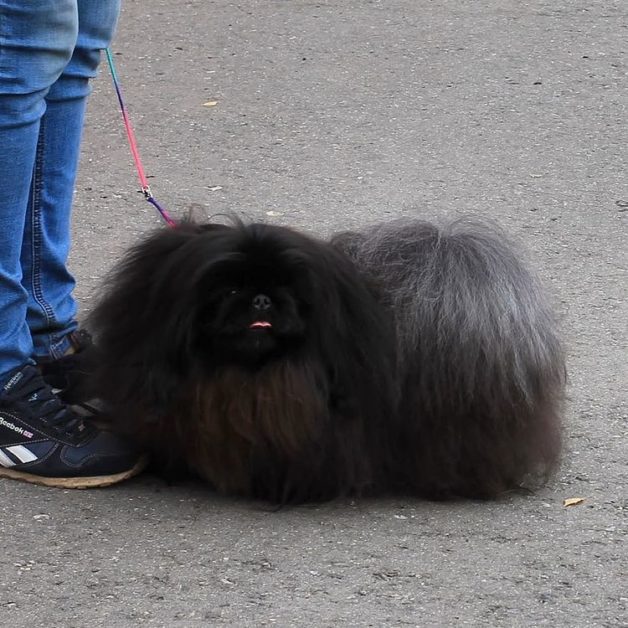
Important! A distinctive feature of the breed is the presence of a lush mane in the neck and shoulders, feathering on the hind legs, as well as long decorating hair on the ears and tail.
According to the current standard, the colors of the Pekingese can be very diverse: black, fawn, variegated, black and tan, two-tone (party color), sand. The most common color of the breed is considered to be red, and the rarest is white.
Moreover, an individual of the white color is recognized as corresponding to the breed standard if its nose, outline around the eyes and lips are pigmented with black color.
What is the difference between Japanese Chin and Pekingese?
Many inexperienced dog breeders often confuse the Pekingese with another decorative dog – the Japanese Chin. At first glance, representatives of both breeds are very similar to each other, but upon closer examination, they can be easily distinguished.
The Japanese Chin looks taller because of its long, slender limbs. In addition, the eyes of the chin are almond-shaped, the coat is smoother and more flowing, and the color is white with black or sometimes red spots.
By its nature, the Japanese Chin is more friendly, obedient, and balanced. These dogs are very fond of, like cats, climbing higher, for example, on the back of the sofa, and watching everything that happens from there. Pekingese, on the contrary, do not favor elevated places but prefer a secluded corner to them.
Another difference between Japanese Chin and Pekingese is the country of origin. The latter, as mentioned above, were bred in China, and Chins – in Japan.
Interesting! Both breeds were considered in their homeland as a kind of amulet that protects the owners’ house from evil spirits.
Black Pekingese: Care & Maintenance
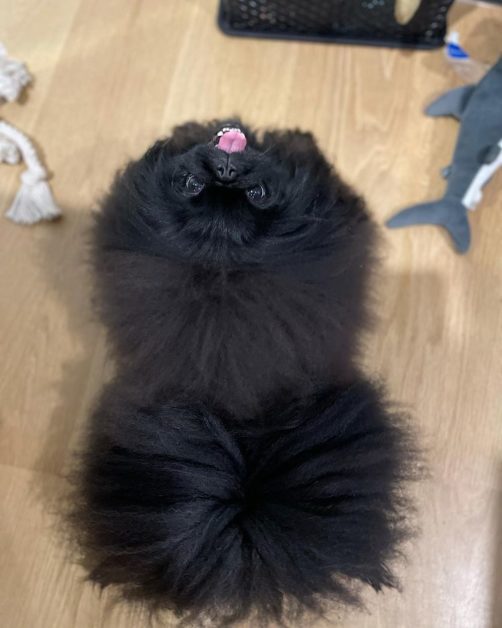
Grooming a Pekingese is no more difficult than a dog of any other breed. The miniature size allows you to keep such a pet in a small apartment. In addition, these dogs are not very energetic, so they do not need long active walks. It is enough to walk twice a day (preferably in the morning and in the evening) for 15–20 minutes, and during hot, rainy, or frosty weather, representatives of the breed prefer to stay at home.
The most effort from the owner will be required when caring for the pet’s coat – it needs to be regularly combed, groomed, and washed. A dog with such a long and thick coat should be brushed daily with a special brush.
Occasionally, you can use a wide-toothed comb to brush out tangles. During periods of seasonal molting, in addition to combing out, you will have to wipe the dog with a damp cloth every day. After each walk, you need to wipe its paws with a damp cloth. It is recommended to bathe 2-3 times a year.
Black Pekingese: Health & Life Expectancy
The average life expectancy of a Pekingese at home is about 18 years. They can be safely attributed to centenarians.
Interesting! Many cases have been recorded when Pekingese lived to be 22 years old.
There is an opinion that if from the first days of the appearance of a puppy in the house, you properly take care of it, he will live much more years. However, this is not entirely true.
In ancient breeds such as the Pekingese, genetics is a decisive factor. Therefore, it is worth taking the puppy from a trusted breeder who can provide copies of the tests and show the veterinary passport of the breeding pair.
Black Pekingese: Pros & Cons
Pros:
- Beautiful and rather original appearance.
- Calm, balanced disposition.
- High intelligence and quick wits.
- Good learning ability.
- They do not misbehave even if they are left alone for the whole day.
- Small handy size.
- Suitable as pets for busy people.
- They are distinguished by incredible dedication.
Cons:
- Arrogant and independent.
- They can engage in a fight with a larger and stronger opponent.
- Not suitable for families with small children.
- They love to put their own order and have their own outlook on life.
- Need regular grooming.
Are prone to a number of specific diseases.
Frequently Asked Questions
Are Black Pekingese rare?
No, Black Pekingese are not considered to be rare but the Black & Tan color is very rare.
How much is a black Pekingese?
A black Pekingese puppy has an average price of $1200-$2800. Some Breeders could even offer black Pekingese puppies for $3500 or even higher.
The cost of a black Pekingese puppy varies widely and depends on many factors. The price of the dog is influenced by the eminence of the breeder, as well as the availability of working and exhibition certificates from the parent couple.
Aside from the puppy’s price, it would be best to consider the expenses that would come with it. For instance, you may want to get the essential things for your puppies like grooming tools, food, and shelter.
Names For Black Pekingese
- Espresso
- Roast
- Burnt
- Pepper
- Grit
- Smoke
- Caviar
- Forge
- Smelt
- Blackberry
- Berry
- Blueberry
- Kettle
- Guinness
- Pepsi
- Coke
- Dr. Pepper
- Mr. Pibb
- Rum
- Whiskey
- Bourbon
- Cola
- Cocoa
- Coca
- Licorice
- Cocoa Puff
- Butler
- Tuxedo
- Tux
- Bosco
- Oreo
- Chocolate
- Anise
- Hershey
Final Thoughts: Is the Black Pekingese a Good Family Dog
Most people think of a small, long-haired, inactive dog when they say Pekingese. Of course, few people would believe that these pretty creatures have a rather complex character. In the loving hands of the master, they become real fluffy “angels” who do not allow themselves indecent behavior not only at home but also on the street.

